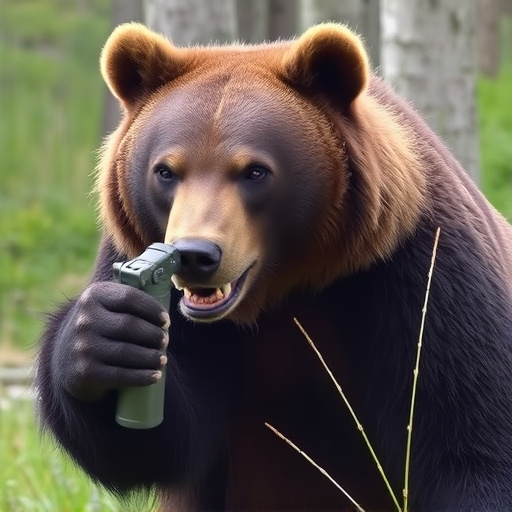Bear spray, an essential tool for protecting against bear attacks, relies on capsaicin (1.3% – 2.5%) as its active ingredient. Understanding the active ingredient percentage (AIP) is crucial when selecting bear spray, with higher percentages offering greater protection by causing pain and disorientation in bears. Effective usage involves aiming at the bear's face and eyes from a safe distance, keeping it accessible, and adhering to manufacturer guidelines and local regulations. Bear spray should be used as a last resort, emphasizing prevention through understanding and preparation.
In regions where bears roam, knowing how to prevent and respond to attacks is vital. One increasingly popular tool in bear country is bear spray equipment. This article delves into the essential components of bear spray, focusing on understanding its active ingredient percentage and how it impacts effectiveness. We’ll guide you through choosing the right spray for your needs and provide critical safety measures to maximize protection during outdoor adventures, ensuring a safer experience in bear country.
- Understanding Bear Spray: How It Works and Its Effectiveness
- Deciphering the Label: Active Ingredient Percentage and Its Significance
- Choosing the Right Bear Spray for Your Needs
- Proper Usage and Safety Measures: Maximizing Protection in Bear Country
Understanding Bear Spray: How It Works and Its Effectiveness
Bear spray, also known as bear deterrent spray, is a powerful tool designed to protect individuals from potential bear attacks. Its effectiveness lies in its active ingredient, which typically contains a high concentration of capsaicin, the same compound found in chili peppers. This active ingredient is responsible for causing a burning sensation in the eyes and respiratory tract of bears when sprayed directly at them.
The success of bear spray depends on several factors, including the correct usage, timing, and understanding of its limitations. Bear spray can be highly effective when used as a last resort during a close encounter with an aggressive bear. It creates a temporary distraction, allowing the user to retreat or seek safety. However, it’s crucial to remember that no spray is 100% guaranteed, and proper training in bear behavior and awareness is essential for maximizing its effectiveness. The recommended active ingredient percentage in bear spray varies between 1.3% and 2.5%, ensuring a strong enough reaction without causing prolonged harm to the animal.
Deciphering the Label: Active Ingredient Percentage and Its Significance
When considering bear attack prevention spray, deciphering the label is crucial. One key element to look for is the active ingredient percentage. This indicates the concentration of the active compound designed to deter bears, usually capsaicin or oleoresin capsicum (OC). A higher percentage signifies a more potent spray, offering greater protection in close encounters.
The active ingredient percentage affects the spray’s effectiveness and range. Higher concentrations provide a longer reach and better chance of stopping an attack, as it can cause pain and disorientation in the bear. This is especially important when navigating dense forests or areas known for frequent bear activity. Remember, understanding this label detail empowers users to make informed decisions regarding their safety in potential bear country.
Choosing the Right Bear Spray for Your Needs
When selecting a bear spray, understanding the active ingredient percentage is key. Look for products with a high concentration of active ingredients like capsaicin or pepper spray, as they are proven to be effective against bears. A typical range for bear spray effectiveness is between 15% and 34% Active Ingredient Percentage (AIP). Lower concentrations may not deter an aggressive attack, while higher ones can provide extra peace of mind without causing excessive discomfort to non-target animals or humans.
Consider your specific needs when choosing a bear spray. Different environments require different strategies. For instance, if you’re hiking in dense forests where encounters are more likely, a can with a larger volume and a stronger AIP might be suitable. In contrast, for casual campers who mostly stay in well-traveled areas, a lighter option could suffice. Always follow manufacturer guidelines and local regulations regarding the use and storage of bear spray equipment.
Proper Usage and Safety Measures: Maximizing Protection in Bear Country
In bear country, proper usage and safety measures of bear attack prevention spray are crucial for maximizing protection. To ensure effectiveness, it’s essential to understand how to deploy the spray correctly. Aim for the bear’s face and eyes, as this is the primary target area. Maintain a safe distance, typically 20-30 feet, before spraying, allowing enough time for the bear to notice you and back away. Always keep your spray readily accessible, such as in hand or on your person, when hiking or camping in areas known for bear activity.
Safety measures extend beyond proper usage. Understanding the active ingredient percentage in your bear spray is vital. Typically, a 2% capsaicin solution has shown to be effective against bears, though higher concentrations may offer additional protection. Keep your spray well-maintained and regularly inspect it for any signs of damage or expiration. Store it securely out of reach of children and pets, and ensure everyone in your party is familiar with its use. Remember, prevention is key; using bear spray as a last resort can be dangerous and ineffective against aggressive bears.
Bear spray is an effective deterrent when used correctly, with the right concentration of active ingredients. Understanding the label and choosing a product suited to your specific needs in bear country is key. Always follow safety measures and proper usage guidelines to maximize protection during outdoor activities. By investing in quality bear spray and knowing how to use it, individuals can enjoy a greater sense of security while navigating areas with bear populations.
